Texas Railroad History - Tower 20 - Bells
A Crossing of the Missouri-Kansas-Texas Railroad and the
Texas & Pacific Railway
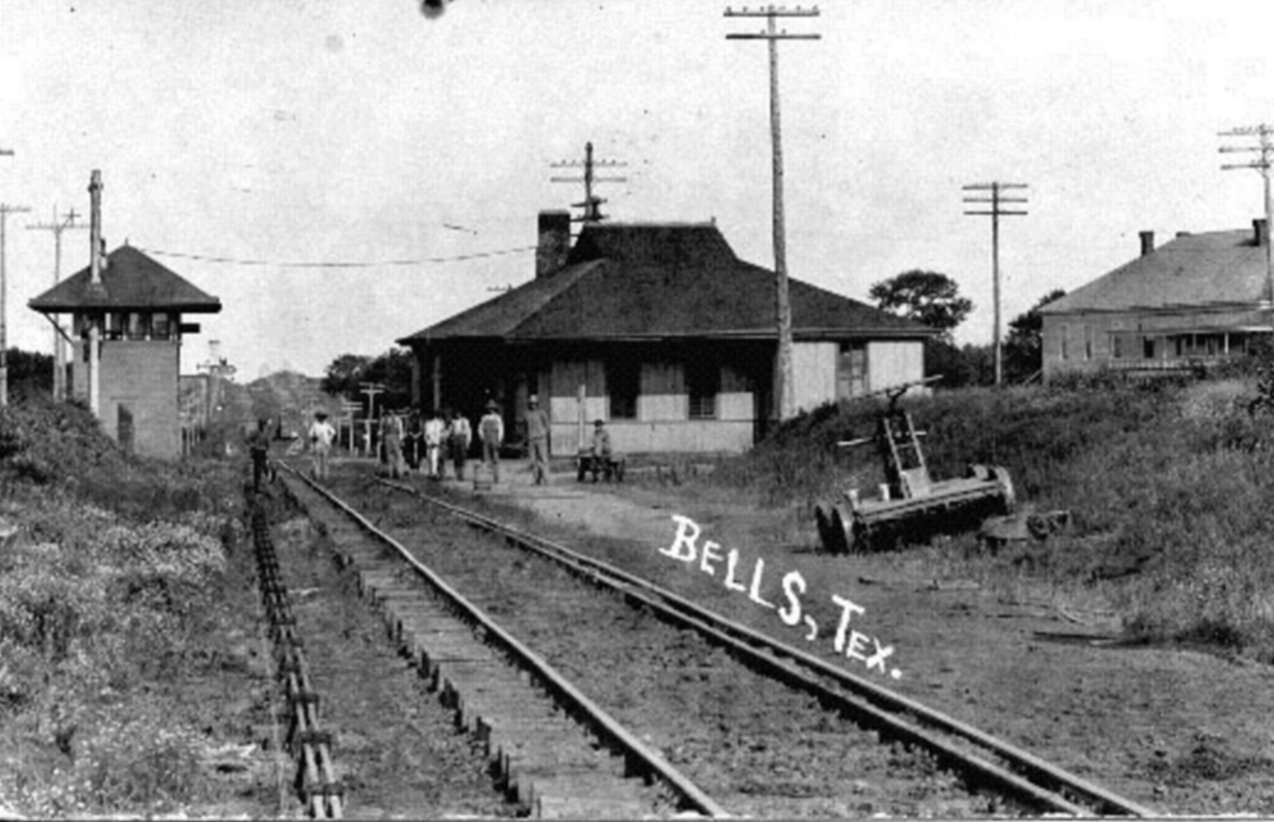
Above:
Tower 20, George Kimbrough collection. George recalls the tower...
"The
tower was located on the northeast corner of the intersection, probably no more
than 8 or 10 feet from both tracks. I remember climbing the steps to the tower
and watching the "tower man," Mr. Troy Griffin, as he pushed and pulled the line
of brightly-colored levers that were taller than I... And there was the
telegraph chattering away with its messages, all quite a treat for a youngster
of six or eight. As for a depot, I only recall there being one depot building,
located 50 feet or so south of the east-west tracks, and southwest of the tower.
Access to the depot and the tower was from the south, parallel to the tracks. As
for memories of the depot...most vivid was the huge coal stove that sat in the
waiting room, and the wooden benches. I also have faint memory of the hook
alongside the track in which the mail sacks would hang, waiting to be snapped up
by those trains that did not stop in Bells."
George's undated image
(likely from a much earlier era than his) faces east down the Texas & Pacific (T&P)
Railroad tracks toward Paris, with the Missouri -
Kansas - Texas ("Katy") Railway crossing at an angle of about 70 degrees in the
near quadrant. The photo
presents a bit of an illusion; the Katy tracks ran west of the tower, between
its west face and the camera from this view, and they passed on the far side
(east of) the depot. Might the image be reversed, i.e. facing west? No, even
though the "Bells, Tex." could have been added after reversal. To the east, the
tracks are perfectly straight allowing a view to the horizon whereas to the
west, a small but unmistakable curve to the left over the next quarter mile past the tower
eliminates any distant view.
At least one source claims that the town of Bells got
its name when church bells sounded to celebrate the railroad's arrival. There
was, however, no town and presumably no church bells when the first one, the Texas &
Pacific (T&P) Railroad, came through in 1873. The
closest community was Duganville, a short distance south of the tracks, named
for the descendants of Daniel Dugan who had settled the area in 1835. Duganville
(sometimes called "Dugansville"...there were lots of Dugans...)
founded their town in 1871, probably so they could request a Post Office. Of
course, a name might also help to attract a station on "the Trans-Continental" as
the T&P was already known to locals. Its Federal charter had been granted by
Congress for the expressed purpose of constructing a southern transcontinental
rail line from Texarkana to California. The T&P built east from Sherman to Brookston
in 1873, passing a little north of Duganville which remained station-less. In fact, Duganville
was just far enough south of the tracks that another community north of the
tracks claimed to be on the T&P at this location.
That community
was Bailey Junction, but it didn't exist until several
years later. It was not until after the Denison & Southeastern (D&S) Railroad
began building out of Denison on September 27, 1877 that Bailey
Junction sprang up where the D&S would cross the T&P. The D&S had been chartered
by citizens of Greenville and
Denison in 1877 to lay tracks between the two
towns. Denison had been founded when the Missouri - Kansas - Texas (MKT, "Katy")
Railroad bridged the Red River in 1872; the town became their base of operations in Texas. Investors envisioned
feeder routes for the Katy as potentially lucrative
opportunities, so New York financiers and venture capitalists lined up behind
the D&S charter as the first such effort.

|
Left:
The Dallas Daily Herald of
September 29, 1877 carried this news snippet regarding the commencement
of D&S construction.
Right:
The Denison Daily News of
January 3, 1878 reported that the D&S had been completed to the T&P
(but doesn't cite a location, perhaps it was still unnamed.) This opened a new route to St. Louis via the T&P's
interchange with the Iron Mountain Railroad (later known as Missouri Pacific) at
Texarkana. |
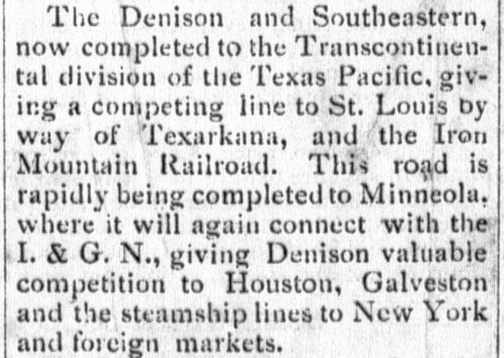 |
According to a history of Bells that appeared in the
Whitewright Sun of April 24, 1969, Bailey Junction was named for
a "Dr. Bailey", a physician who bought land on the north side of the T&P tracks
and laid out streets, presumably in anticipation of the arrival of the D&S. He
reportedly donated land for a cemetery, now called North
Cemetery, directly beside the D&S tracks about seven-tenths of a mile northwest
of the crossing. The earliest mention of Bailey Junction in local newspapers appears to
be the January 15,
1878 edition of the Denison Daily News
which reported that a drug store would open at "...Bailey Junction, the new town at
the intersection..." of the two railroads. But only eleven days later, the paper
reported that trains would begin running from Denison "...to Bailey Junction, or
Bellville as it is now called...".
The
Whitewright Sun story asserts that an argument between Dr. Bailey
and the Dugans over which community could rightfully claim the junction was
at an impasse, and that a compromise name was chosen instead. Bellville
was apparently the original compromise, but the locals
didn't realize that Bellville, Texas had already existed for nearly thirty years as the
county seat of Austin County, hundreds of miles to the south. They must have
been informed quickly by the Post Office because on February 19, 1878, the
Denison Daily News reported that a "Dr.
Bailey" would soon be relocating his drug store from the community of Savoy
(three miles farther east on the T&P) to the town of "Bellplain"
(French: beautiful flatland) at the junction, where six buildings had
already been erected. A follow-up story on April 4th announced that Bellplain
had four general stores, three saloons, and two drug stores, one of them owned
by Dr. Bailey "late of Savoy." Was this the same Dr.
Bailey who bought up the land to create Bailey Junction? Most likely, since he
could have been both a pharmacist and a physician. The two weren't all that
different in the 1870s; the other drug store in Bellplain was owned by former
Denison physician Dr. G. S. Faute.
The Whitewright Sun
article says that Dr. Bailey eventually relocated to Fannin County where he
founded the town of Bailey. If so, he was Dr. Josiah Bailey, according to the
history of Bailey in the
Handbook of Texas. But the
Handbook also reports that Dr. Josiah
Bailey argued with another Fannin County landowner over the name of
that town as construction of
another railroad, the St. Louis
Southwestern ("Cotton Belt") Railroad, approached their unnamed community in 1885.
Either Dr. Josiah Bailey liked to buy land in the path of approaching railroads
and argue about town names, or the histories of Bailey and Bailey Junction became...comingled...over
the succeeding hundred years. Meanwhile, a Bonham News
editorial printed in February, 1878 was already convinced
that Bailey Junction would soon rival Sherman and
Denison for economic dominance in Grayson County, not knowing that Bellville and
then Bellplain had become the locally preferred name. Or maybe not...
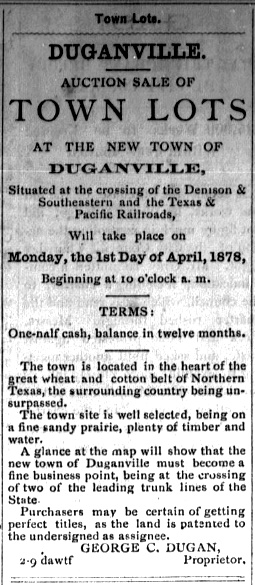 |
Left: Determined to be a player in the junction naming contest, the townsfolk of Duganville got involved. An ad in the
Denison Daily News of March 8, 1878
announced an auction of town lots to be held on the first day of April in Duganville.
The claim to being "situated at the crossing" was no doubt fightin'
words
to the people living in Bailey Junction or Bellville or Bellplain (or Bellvue, another short-lived name), who thought their community was at the
junction.
Below: On
March 19th, the Denison Daily News
reported on the opening of the Post Office at Bellplain.
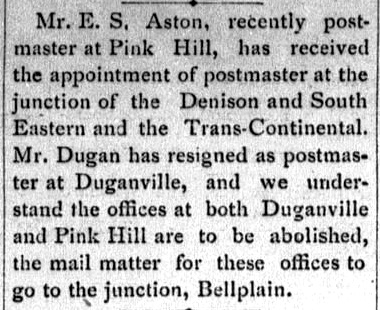
Right: Bailey Junction
didn't fade quietly. The Sherman Register
(as reprinted in the Denison Daily News
of June 18, 1878) had some fun with the size and location of Bailey
Junction, apparently in response to an enquiry from the
Marshall Herald. For many more
years, the Dallas Daily Herald
included "W. T. Gass, Bailey Junction" in a list of its agents in
outlying towns. |
 |
When the Post Office appointed a Postmaster for Bellplain, the matter was
settled...until it wasn't. Another Texas town, Belle Plain,
had been founded in 1876 in Callahan County, and confusion in mail delivery began immediately.
Unfortunately, the Post Office was in no mood to make yet another un-researched
name change. And despite the anticipated closing of the Post Office
at Duganville, the Denison Daily News
of June 15, 1878 included a plea from their Duganville correspondent... "Please state that
the name of our Post Office is Duganville not Bellplain or Bailey Junction, as a
great many think. By so doing you will confer a kindness on the public
generally, more especially those whose mail goes to Bellplain, county seat of
Calahan [sic] County, Texas." Unfortunately, public kindness was
not enough, and Bellplain continued to suffer mail confusion. Seven months
later, the Denison Daily News
of January 31, 1879 printed yet another warning from a concerned citizen (most likely a Dugan
trying to help justify retention of their Post Office)
... "Parties writing letters to Bellplain should be careful and direct to
Duganville, the proper postoffice [sic] address" or their
mail might end up at "... Bellplain in Callahan County...".
Finally (but not
really finally), Post Office management in
Washington, D. C. agreed to a new name, Bell Station. A major celebration and dinner
was scheduled for October 1, 1879 to commemorate the first day in the history of
the new town. At least, that's what was reported by the
Sherman Courier newspaper (as reprinted by the Denison Daily News on
September 27, 1879.) On October 2, 1879, the Denison
Daily News acknowledged the celebration the previous day, but reported
the name as Bells with no mention of Bell Station. Whether the celebratory sound of church bells influenced a
last minute name change from Bell Station is unreported. Regardless, the town
would be known as Bells and the matter was truly, finally settled.
 |
Upper Left: Undoubtedly with tongue firmly in cheek,
the Denison Daily News of October 2,
1879 announced that Bellplain had become the new town of Bell, named for the bell punch. Readers
surely got a laugh at that one as the bell punch would be one of the least
honor-worthy items a citizen could think of. It was particularly
disliked by those who bought or sold alcohol since it
led to better enforcement of liquor taxes, something neither alcohol
retailers nor their customers wanted to honor.
The bell
punch was a mechanical device that saloons and other purveyors were
required to purchase from the Texas Comptroller (for $10 each; two were
generally required) to be used as a means of tracking alcohol sales for
tax purposes. The device rang a bell and advanced a counter when cranked
one full revolution. The bell enabled customers and anyone else who might be present
(e.g. undercover informants and tax agents)
to know that a liquor purchase had been properly counted for tax
purposes. The counter accumulated the total cranks, from which the
tax owed by the establishment could be calculated periodically.
The normal assessment was one drink, one crank; a pint of liquor, four
cranks; a quart of malt liquor, two cranks on a machine dedicated to
such beverages since the tax rates for hard liquor and malt liquor products were
different.
Lower Left:
Coming clean after proclaiming the town of Bell, and without
explanation but with pun intended, Bellplain became plain "Bells", and a great
celebration was enjoyed by all, except perhaps the Dugans and Doc
Bailey, if he hadn't yet relocated to Fannin County. [Editor's Note:
Bailey exists! My father-in-law Bernard Clayton was born there. The same
cannot be said for Bailey Junction.] |
As ink was being spilled over the name of the
junction, the D&S continued building seven additional miles southeast, arriving
in Whitewright in March or April, 1878. The town had been founded by William Whitewright, a
member of the D&S Board of Directors who just happened to know precisely
where to invest in land. The D&S did not build beyond Whitewright for two years, but during
that time, regular trains were operated by the Katy between Denison, Bells
(Bellplain for the first 18 months) and Whitewright. Since the plan all along
was that the Katy would buy the D&S, it's doubtful the D&S ever intended to
acquire their own rolling stock. Presumably the Katy paid the D&S for the privilege
of using their tracks, but evidence of a formal lease has not
been found.
During the two years of construction stoppage in Whitewright, the Denison &
Pacific (D&P) railroad was chartered to build 42 miles west from Denison to
Gainesville. It was both finished and abandoned during this period! In January,
1880, a newspaper report suggested that both the D&S and the D&P had been
acquired by a group of Katy stockholders and bondholders. The newspaper didn't
say it, but these were major
investors most likely acting unofficially on behalf of the Katy. On March 11, 1880, the D&S acquired the D&P.
Twelve days later, the D&S modified its charter to include the newly
purchased westward
expansion while also taking a new name: the Missouri, Kansas &
Texas Extension Railway.
In April, 1880, an article in the
Denison Daily News described the D&S
as "owned and operated" by the Katy. While this wasn't technically true, it did
convey the reality on the ground: the Katy had been running trains to
Whitewright for two years and the public perceived the D&S as a Katy
operation all the way, regardless of the name or who legally owned the tracks. The
article did not even mention the new "Extension" name, a name that merely
conveyed what everyone knew, the Katy was building an extension to Greenville -
the financial details would be sorted out later. Under the Extension name, construction
resumed from Whitewright and was completed to Greenville during the remainder of 1880. The
Katy formally acquired "the Extension" in November, 1881.
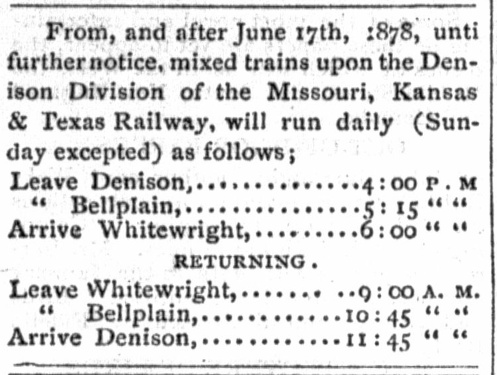 |
Left: The
Denison Daily News of June 17, 1878
published this schedule for service by the Katy from Denison to
Bellplain continuing to Whitewright and return, with no mention of the
D&S. With the Katy operating the line, it made sense to have Katy
station agents at the towns served. A visit to Denison by the Katy agent
at Bellplain was considered newsworthy on January 28, 1879 (right.) |
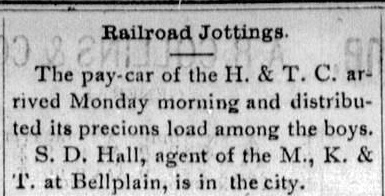 |
The town of Bells hosted one of the
early manual interlocking towers in
Texas, approved by the Railroad Commission of Texas (RCT) as Tower 20 on July
27, 1903. Although state law assigned the capital expense for an interlocking
tower to the second railroad (i.e. the one that created the need by building
across an existing rail line of another company), this only applied to crossings created after the
law took effect in 1901. For crossings that predated 1901 such as this one, the
law required the capital expense to be shared by the railroads. The interlocker
was a 12-function mechanical plant built by Union Switch & Signal Co. of
Pittsburgh, PA. Twelve functions was the minimum for a simple crossing of two
railroads, consisting of a home signal, distant signal and derail in each of the
four directions.
A table of interlocker details published by RCT dated December
31, 1916 shows that Tower 20 was operated by T&P personnel, which tends to imply
that the tower was also designed and built by the T&P. Unlike post-1901 capital
costs, recurring costs such as staffing and supplies for operations and
maintenance (O&M) were shared by the railroads on a "weighted function" basis. A
12-function interlocker such as this one would have been shared 50/50 since each
railroad had six interlocker functions. The 1931
RCT annual report showed the function count for Tower 20 remained 12, unchanged
after nearly three decades. To have no changes over that span was rare for
manned towers (but not unheard of, e.g. Tower 31
which also had 12 functions, and Tower 34 which had
28.) This tends to imply that the Bells connecting track that existed at least
by the 1950s
may not have been in place at the start of 1931; the switches required for
the connector would typically result in additional interlocker functions.
There was one very significant change at Tower 20 that occurred in 1923. RCT's
table of interlockers dated December 31, 1923 was the first to show the Katy
railroad as the operator of the interlocker (by being the first railroad listed
for that tower), and it remained as such through the last table published at the
start of 1931 (subsequent RCT annual reports omitted the table.) The Katy taking
over tower operations was probably due to the cumulative increase in priority traffic on the Katy
paired with a decrease in traffic on the T&P. The T&P had by this time begun to
treat its southern route between Ft. Worth and Texarkana via
Dallas and Marshall
as the true "main line". The northern route from
Ft. Worth to Texarkana via
Sherman, Bells and Paris had become a secondary route.
The Katy meanwhile was
operating priority passenger trains from Dallas to
Oklahoma and the midwest that passed through Bells. It's likely that by 1923,
traffic had evolved to where uninterrupted service past Tower 20 was
substantially more important to the Katy than the T&P. The Katy may have asked
to take over operations at Tower 20 to ensure that it received priority for
staff (and backup) assignments, probably including maintenance as well
(technically, one railroad could operate the interlocker while the other
maintained it, but this would have been rare.) The Katy could devote resources
to ensure that a failure at Tower 20 could be prioritized to be addressed
quickly whereas the T&P might have had less interest in resolving Tower 20
maintenance issues so rapidly. The T&P tracks through Bells did not carry frequent, priority trains.
The change in staffing
might also have spurred negotiations on
how O&M costs would be shared. If, as a hypothetical example, the T&P had no
trains scheduled at night, they would not have wanted to fund the tower for
24-hour operations. Interlocking towers sometimes had limited daily and Sunday
hours of operation, and down the road in Whitewright,
Tower 101 eventually operated on a less than 24-hour basis. This was
feasible by leaving the signals lined to allow continuous movements on the Katy.
The crew of a Cotton Belt train that unfortunately found themselves approaching
the Whitewright tower after hours would have followed specific procedures to
contact the towerman "on call" to change the signals to allow passage. The
ultimate solution was to automate the interlocker which became feasible in Texas
at the start of the 1930s. Whitewright's interlocker was automated in late 1943
after which the tower was no longer staffed (but the structure may have remained
intact for some period simply to house the automatic interlocking plant.)
The presence of an operator at Tower 20 when 8-yr. old George Kimbrough
(born in October, 1941) visited c.1950 suggests that it remained a manual
operation at that time, but whether it was staffed 24/7 is unknown. Railroad
employee timetables indicate that the Tower 20 interlocker was automated in the
late 1950s or early 1960s; the fate of the tower structure (and its date of
removal) has not been determined. In some later timeframe, the Tower 20
automatic interlocker was replaced with a cabin interlocker (known because there
are photos of it.) This would have been done to save maintenance costs and
improve reliability, mechanical cabin interlockers being much simpler than
automatic ones and appropriate for a crossing where a lightly used track (the
T&P) crossed a busier track (the Katy.) The controls in the cabin were operated
by a train crewmember from the lightly used line when his train needed to cross.
 |
Left: This
historic aerial image from 1955 (with magnification at
right) shows Tower 20
in the 110-degree northeast quadrant of the diamond, diagonally across from the
Bells union passenger station, casting a shadow to the north. An
exchange track in the southwest quadrant sits well behind the depot and
might also have been used for train reroutes, e.g. during various track
outages. Northbound Katy trains could easily reach Denison by taking the
connector, going east on the T&P and turning north to Denison on Katy's
branch at Sherman. A 1956 Katy employee timetable notes that passenger
trains were allowed to cross the T&P at Bells at a maximum speed of 35
mph; freight trains were limited to 20 mph. ((c)historicaerials.com) |
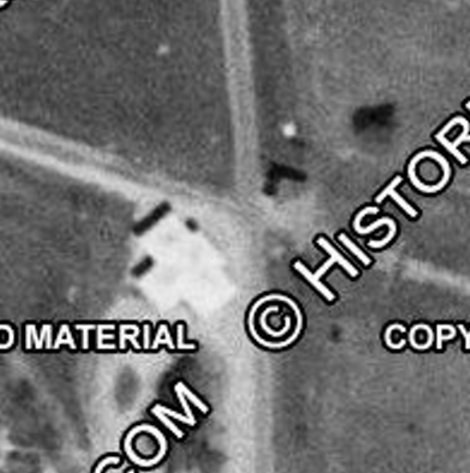 |
The T&P had worked closely with the Missouri Pacific
(MP) Railroad for more than thirty years beginning in the 1880s when they were
both under the control of rail baron Jay Gould. By 1918, Gould was no longer in
control of either railroad, and the much larger MP approached the T&P about
establishing a financial relationship between the two companies. Subsequently,
MP began acquiring T&P stock and by the early 1930s, MP owned about 75% of the
shares. Yet, MP chose not to exercise operational control over the T&P. The two
railroads continued their working arrangement, with the T&P becoming closely
integrated by the 1960s and then formally merged into MP in 1976.
In
1982, Union Pacific (UP) acquired MP but continued to operate it as a subsidiary
railroad. In 1988, UP acquired the Katy and merged it into MP. The 15 miles of
Katy track between Bells and Denison was immediately abandoned. Northbound
trains on the Katy began taking a relatively new (post-1981) connecting track in
the southwest quadrant at Bells to go west to Sherman.
From there, they could go north as necessary on the Katy's branch out of
Denison; the reverse route was used for southbound trains. In 1990, the Texas Northeastern (TNER) Railroad acquired all of the
tracks through Bells as a short line operator. The tracks west to Sherman and
south to Whitewright (and beyond) are in service by TNER. East of Bells, the tracks are now
mostly intact but apparently out of service to Bonham. Between Bonham and Paris,
the rails are in place but many of the grade crossings have been paved over.
From Paris east to New Boston, the former T&P is abandoned and much of the
right-of-way is in use as a trail.
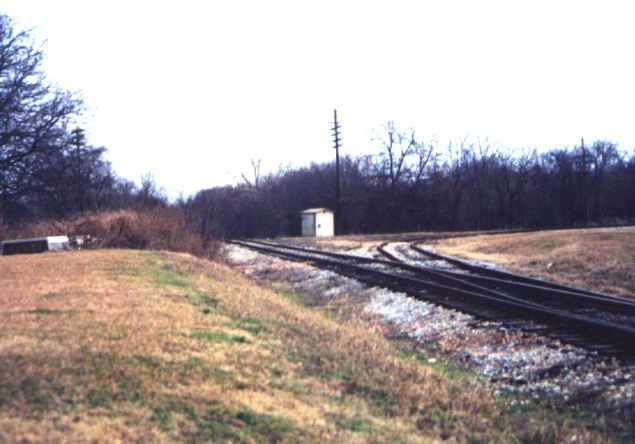
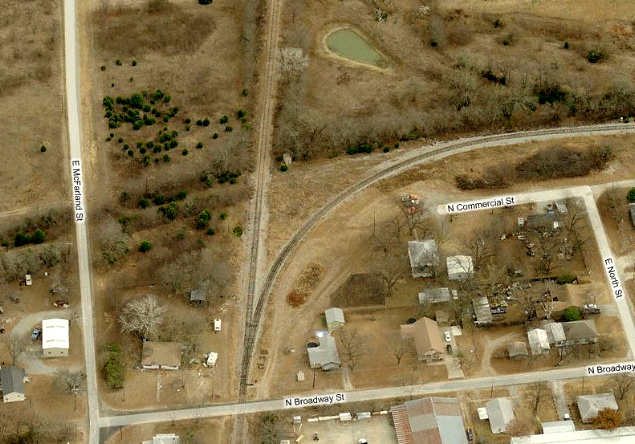
Above
Left:
Tracks, and a non-functional cabin interlocker, are all that's left at the Tower 20
crossing in this 1996 photo. The former Katy track to the right heads south to Whitewright
while the former T&P track to the left heads east to Bonham. The connecting
track is much closer to the crossing than it historically was. Aerial imagery
shows that at some point between 1957 and 1981, the original connecting track in
the southwest quadrant was removed. A new connector in the same quadrant was
built sometime after 1981 but prior to the removal of the Katy tracks north of
Bells in 1988. The connector crosses land that originally hosted the Bells Union
Depot. (Jim King photo)
Above Right: This aerial image c.2008 faces east barely showing
the cabin interlocker at the former crossing. The ex-T&P tracks remain intact
but out of service (though sometimes used for railcar storage.) The former Katy
line was abandoned to the north 30 years earlier but
the right-of-way is still apparent. The connector in the southwest quadrant is
now effectively the main line.
Below Left: Facing east from N. Broadway St., two locomotives
sit on the connector. The gravel in the foreground is the faint remnant of the
grade of the original connecting track. (Note in the 1955 image further above
that both the main track and the connector cross N. Broadway St.; the connector
switch was west of Broadway.) Below Right:
The same two locomotives are viewed facing north from the north end of
Commercial St. Given the minute or so it would take the Google Street View car
to move between these two vantage points, it's safe to conclude the locomotives
were stationary. By 2013 when this image was captured, the abandoned cabin seen in the 2008 aerial image was no longer
present off to the right. At the base of the substantial tree line
behind the green locomotive, the former T&P tracks to Bonham are faintly
visible. By 2013, the trees had completely engulfed the former Katy right-of-way
to the north, leaving no apparent trace. (Google Street View, 2013)
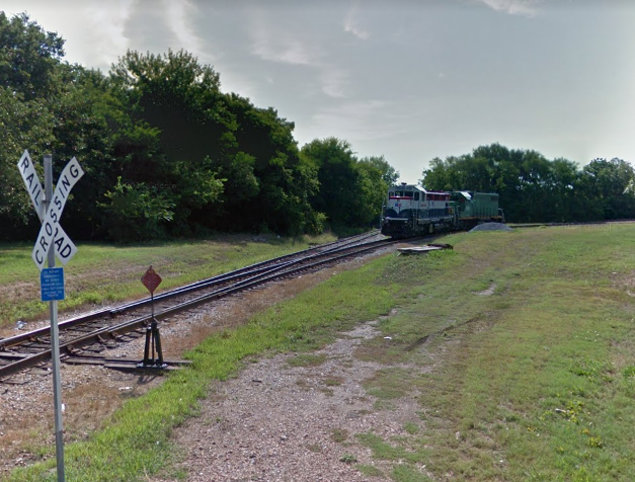
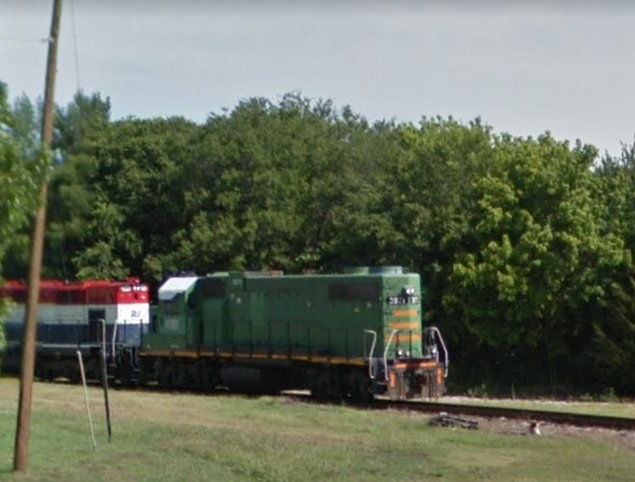
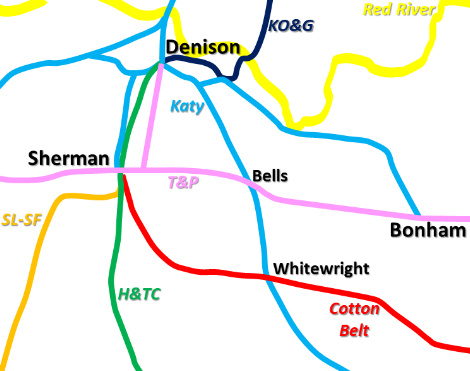 |
Left:
This area map shows the historic rail lines in the vicinity of Bells. In
1890, plans had been made to build yet another feeder line out of
Denison, one that would be routed due south via Sherman. The Sherman,
Denison & Dallas (SD&D) Railway was chartered for this purpose
(blue line between Sherman and a connection west of Denison.) The Katy
did need its own line to Sherman, at
minimum to compete with the Houston & Texas Central (H&TC) line owned by
Southern Pacific. Sherman was a population center, larger than Denison,
and was a source of passenger traffic. The SD&D completed ten miles of
track from Denison to Sherman in 1890, and the line was formally
acquired by the Katy in 1891. This branch provided part of the route
between Denison and Bells when the Katy tracks north of Bells were
abandoned in 1988.
In 1896, the T&P proceeded to build tracks from Sherman to Denison
(pink line from east of Sherman to near Denison) under the charter of the Denison & Pacific
Suburban (D&PS) Railroad. The tracks went eight miles north to Denison
departing from the T&P main line three miles east of Sherman. Its
impetus was essentially the reverse of the SD&D, i.e. Denison was a
source of traffic for the T&P via Sherman to points east (Texarkana) and
west (El Paso.) This branch was abandoned in 1966, hence it was not an alternate route to Denison for trains taking the
connector west from Bells after the Katy merger into MP in
1988.
Other railroads in the vicinity of Bells were the St. Louis
- San Francisco (SL-SF), the Kansas, Oklahoma & Gulf (KO&G) and the St.
Louis Southwestern ("Cotton Belt"). |















